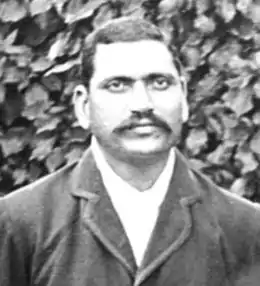Palwankar Baloo
Palwankar Baloo was the first Dalit to become a cricketer (left-arm orthodox spin bowler) and was also a political activist.
 | |||||||||||||||||||||||||||
| Personal information | |||||||||||||||||||||||||||
|---|---|---|---|---|---|---|---|---|---|---|---|---|---|---|---|---|---|---|---|---|---|---|---|---|---|---|---|
| Full name | Palwanker Baloo | ||||||||||||||||||||||||||
| Born | 19 March 1876 Dharwad, Bombay Presidency, British India | ||||||||||||||||||||||||||
| Died | 4 July 1955 (aged 79) Bombay, Bombay State, India | ||||||||||||||||||||||||||
| Bowling | Left-arm orthodox spin | ||||||||||||||||||||||||||
| Role | bowler | ||||||||||||||||||||||||||
| Relations | P Shivram (brother), P Ganpat (brother), P Vithal (brother) | ||||||||||||||||||||||||||
| Domestic team information | |||||||||||||||||||||||||||
| Years | Team | ||||||||||||||||||||||||||
| 1905–1921 | Hindus | ||||||||||||||||||||||||||
| First-class debut | 8 February 1906 Hindus v Europeans | ||||||||||||||||||||||||||
| Last First-class | 8 December 1920 Hindus v Parsees | ||||||||||||||||||||||||||
| Career statistics | |||||||||||||||||||||||||||
| |||||||||||||||||||||||||||
Source: ESPNcricinfo, 27 January 2009 | |||||||||||||||||||||||||||
Early life
Palwankar Baloo was born into a Chambhar caste family in Dharwad, Bombay Presidency, British India. His father was a sepoy in the 112th Infantry Regiment of British Indian Army. Baloo played cricket with equipment left behind by officers stationed in Pune.[1]
Baloo had three brothers, Palwankar Shivram, Vithal Palwankar and Palwankar Ganpat, who also became known as cricketers.
Cricket career
He started working as a groundsman maintaining the pitch for the Parsis in Pune and later at the British Poona Gymkhana where he occasionally bowled to J.G Grieg, an English batsman. He learned spin bowling.and because of Grieg's influence he began to play for the Pune Hindu club. The club had been reluctant to let him play because of his "untouchable" caste..[2][3]
In 1896, he moved to Bombay and was selected by Parmanandas Jivandas Hindu Gymkhana and played both Bombay Quadrangular tournaments.[4]
He was employed by the Bombay Berar and Central Indian Railways, and also played for the latter’s corporate cricket team.
He played in the all-Indian team led by the Maharaja of Patiala during their tour of England in 1911. The tour was a failure, but Baloo's outstanding performance was well praised.[5]
Throughout his career in cricket, Baloo was not perceived as equal due to his dalit background. He faced much discrimination because of this. Whilst he played at Pune, during the tea interval at matches his tea was brought outside to him in a disposable cup. He could not drink it in the pavilion. His lunch was served at a separate table. If he wanted to wash his face a fellow Dalit attendant would bring him water in a corner. Things seem to have improved when he moved to Bombay and afterwards but he was denied the captaincy of the Hindu team in the Quadrangular Tournament.[2][6]
He is considered to be one of the greatest cricketers in Indian cricket history.[7]
Politics
He was greatly influenced by Gandhian ideology and worked to bring Home Rule to India.
In the 1910s, Palwankar Baloo met Dr. B.R. Ambedkar and became his close friend. They admired each other and worked to improve the Dalit community. However in 1932, Baloo opposed Dr. Ambedkar's demand for separate electorates for the depressed classes. Later, he also signed the "Rajah-Moonje Pact" in opposition. He described conversion of Dalits to other religions as 'suicidal' when Ambedkar expressed his intention to convert to Buddhism.[8]
In 1933, Baloo unsuccessfully contested the Bombay Municipality constituency against Hindu Mahasabha. Four years later he joined Congress and contested the Bombay Legislative Assembly elections against Dr. B.R. Ambedkar, but lost.[9]
He died in 1955. His funeral was attended by many national leaders as well as cricketers.[10]
See also
References
- "The 'Untouchable' Cricketer Who Challenged the British & His Fellow Countrymen". The Better India. 18 September 2018. Retrieved 3 June 2020.
- Jyoti, Dhrubo (16 September 2018). "Why India has forgotten its first Dalit cricketer". ThePrint. Retrieved 3 June 2020.
- Guha, Ramachandra (2002). A Corner of a Foreign Field. The Indiuan history of a British Sport (2003 Paperback ed.). London: Picador. p. 90. ISBN 0-330-49117-2.
- "India's first Dalit cricketer Palwanker Baloo fought against caste barriers on the field and off it". Hindustan Times. 16 September 2018. Retrieved 3 June 2020.
- Kidambi, Prashant (30 June 2019). "From disdain to heroes — the journey of two Dalit brothers in India's first cricket team". ThePrint. Retrieved 4 June 2020.
- Ramchandra Guha : Pages 89-91 and 126-130
- "Palwankar Baloo, the Dalit bowler, was the "first great Indian cricketer"". Retrieved 4 June 2020.
- "Yahoo Cricket". cricket.yahoo.net. Retrieved 4 June 2020.
- Menon, Dilip M. (2006). Cultural History of Modern India. Berghahn Books. ISBN 978-81-87358-25-1.
- Kidambi, Prashant (2019), Cricket Country: An Indian Odyssey in the Age of Empire, Oxford University Press, ISBN 978-01-98843-13-9
- Guha, Ramachandra (2003), A Corner of a Foreign Field: The Indian History of a British Sport, Pan Macmillan, ISBN 0-330-49117-2
- Guha, Ramachandra (2006), Menon, Dilip M. (ed.), Cultural History of Modern India, Berghahn Books, pp. 1–31, ISBN 978-81-87358-25-1
Further reading
- Guha, Ramachandra (2005). ""The Moral That Can Be Safely Drawn From The Hindus' Magnificent Victory": Cricket, Caste and the Palwankar Brothers". In Mills, James H. (ed.). Subaltern Sports: Politics and Sport in South Asia. Anthem Press. ISBN 978-1-84331-168-3.
